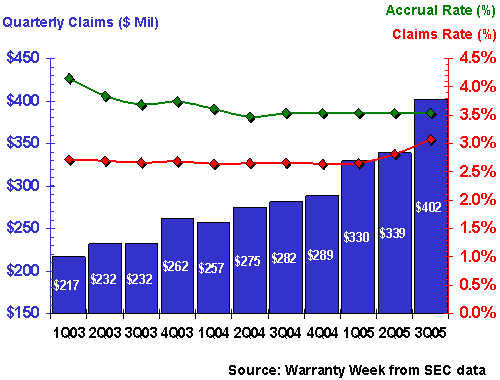November 9, 2005 |

|
ISSN 1550-9214 |
Computer Warranties:It's entirely possible that HP, Dell, and IBM are each now paying roughly the same percentage of their hardware revenue to satisfy warranty claims. A year ago, HP was paying much more, and Dell and IBM were paying less.Top computer manufacturers based in the U.S. have paid out just under $4 billion in warranty claims during the first three quarters of 2005, equivalent to around 3.2% of their total computer hardware revenue over the same period, according to statistics compiled by Warranty Week. We're now well into the third quarter earnings reporting season, and by press time all the major computer vendors except Apple Computer Inc. had filed their latest quarterly financial report with the U.S. Securities and Exchange Commission. Apple, which closes out its fiscal year at the end of September, is not expected to file its annual report with the SEC until early December. To fill that gap, Warranty Week has inserted placeholding estimates for Apple into the charts that follow. When the actual data becomes available in December, we'll recompute these charts using the new numbers. Dell Inc. and Hewlett-Packard Co., meanwhile, are on fiscal years that end on Jan. 31 and Oct. 31, respectively. As with other companies not on a strict calendar year schedule, we're transposing their fiscal years based on the calendar quarter in which they end. Therefore, Dell's fourth fiscal quarter is transposed to the first calendar quarter (since it ends in January), and HP's fiscal fourth quarter is mapped to the calendar fourth quarter (since it ends in October). Increasing Warranty ClaimsFor each of these computer manufacturers, along with International Business Machines Corp., Sun Microsystems Inc., Gateway Inc., Palm Inc., and several others, we now have at least 33 months of warranty claims and accrual data in hand, stretching back to at least the beginning of 2003. What that data shows is that warranty claims, at $1.36 billion in the third quarter, have never been higher, but are in the middle of the range they have established over the last 11 quarters as a percentage of revenue. In other words, revenue is rising at more or less the same rate as warranty claims. However, claims have risen rather suddenly and recently at both IBM and Dell, and have fallen significantly at HP, to the point that each of these "big three" may now be paying roughly three-and-a-half percent of their product revenue to honor warranty claims. That's an astonishing change from past patterns. The following chart shows actual dollars paid by HP, Dell, IBM, Sun, Apple, Palm, and Gateway over the past 11 quarters. The data for HP, Dell, and IBM is labeled, but labels wouldn't fit for Sun (yellow), Apple (orange), Palm (purple), or Gateway (green). Since Apple has yet to report its latest quarter, we've simply repeated the $50 million in claims that they reported for the second calendar quarter. All other data reflects actual reports filed with the SEC through the close of business on Nov. 9, 2005. Top U.S.-based Computer Manufacturers | |||||||||||||||||||||||||||||||||||||||||||||||||||||||||||||||||||||||||||||||||||||||
| Go to Part Two |

|
This Week’s Warranty Week Headlines | ||
|
Bombardier lengthens the warranty on the Learjet 60 to five years. Flight International, November 9, 2005 | ||
|
Pratt & Whitney Canada Corp. unveils the Eagle Plus Warranty Program, bridging the gap between its jet engine product warranties and existing service plans. Press Release, November 9, 2005 | ||
|
Jet Aviation Singapore will become the first authorized service center for Boeing Business Jets in the Asia Pacific region. Press Release, November 8, 2005 | ||
|
Raytheon Aircraft Company places a five-year warranty on the airframe, engines, and avionics of the new Hawker 850XP. Press Release, November 8, 2005 (PDF file) | ||
|
Warranty Direct UK allows customers to build their own extended warranties, including or excluding specific components. ITV Motoring, November 9, 2005 | ||
More Warranty Headlines below | ||

|
Warranty Headlines (cont’d) | ||
|
Harris Interactive survey finds 50% of respondents see warranty as a factor that has a great deal of impact on their purchase considerations. Press Release, November 8, 2005 | ||
|
South Florida's local roofers say out of state firms' warranties are meaningless. Miami Herald, November 8, 2005 | ||
|
Distributors of RedMax/Komatsu Zenoah outdoor power equipment to use ServiceBench to manage warranty claims. Press Release, November 7, 2005 | ||
|
Celestica Inc. acquires Displaytronix, a company engaged in the repair, recovery and replacement of flat-panel displays. Press Release, November 7, 2005 | ||
|
North Korea's Choson Bugang Trading Co. apparently grants warranties on motorcycles imported from China. JoongAng Daily, South Korea, November 5, 2005 | ||
More Warranty Headlines below | ||

|
Warranty Headlines (cont’d) | ||
|
Service Net Solutions LLC to administer service plans for Toshiba America Information Systems Digital Products Division. Press Release, November 4, 2005 | ||
|
Warrantech Home Service Company launches new Web site featuring cartoon character Wally Warrantech. Press Release, November 3, 2005 | ||
|
ServiceMaster reports revenue up 8% and earnings up 9%; American Home Shield revenue up 12% but income down 2%. Press Release, November 3, 2005 | ||
|
Aon Corp. reports third quarter net income of $122 million or 36 cents per share, same as in 2004. Press Release, November 3, 2005 | ||
|
Mazda North American Operations to give $500 to owners of recalled 2006 Mazda5 compact minivan and restart their warranties on Dec. 1. Automotive News, November 3, 2005 | ||
More Warranty Headlines below | ||

|
Warranty Headlines (cont’d) | ||
|
Epson Australia doubles the warranty on the Epson Stylus CX3700 multifunction printer to boost sales. Buy-n-shoot, November 2, 2005 | ||
|
State Farm Mutual Insurance Co. sued over salvaged car title settlement. Associated Press, November 2, 2005 | ||
|
Attorney David P. Meyer says numerous consumers are looking to join his iPod Nano class action lawsuit against Apple. PC Magazine, November 1, 2005 | ||
|
Gregg Appliances Inc., also known as hhgregg, transfers its extended service plans to General Electric Co. and pays GE $21.5 million to administer them. Press Release, November 1, 2005 | ||
|
Lawsuit brought by Penn Warranty against operator of a Web-based "gripe site" is dismissed; judge rules comments to be protected opinions of a disgruntled consumer. New York Law Journal, November 1, 2005 | ||
More Warranty Headlines below | ||
|
|
Warranty Headlines (cont’d) | ||
|
International TechneGroup Inc. says it helped Sweden's Volvo Penta reduce warranty claims by 30%. Press Release, November 1, 2005 | ||
|
Tire sellers and manufacturers differ on the merits of having new tire treads "siped." KOMO-TV Seattle, November 1, 2005 | ||
|
Longtime ThinkPad owner upset with the transition from IBM to Lenovo warranty service. InfoWorld, November 1, 2005 | ||
|
Four executives of Accord Customer Care Solutions face conspiracy charges for faking warranty claims. Channel News Asia, October 31, 2005 | ||
|
DaimlerChrysler says it has received only a small number of warranty claims on steering problem found in Dodge Dakota and Durango. Associated Press, October 31, 2005 | ||
More Warranty Headlines below | ||

|
Related Articles From Warranty Week |






